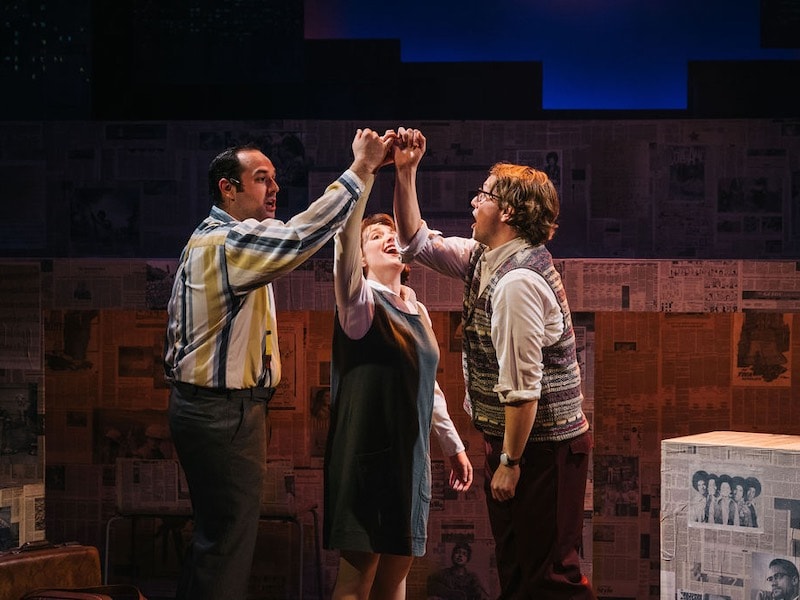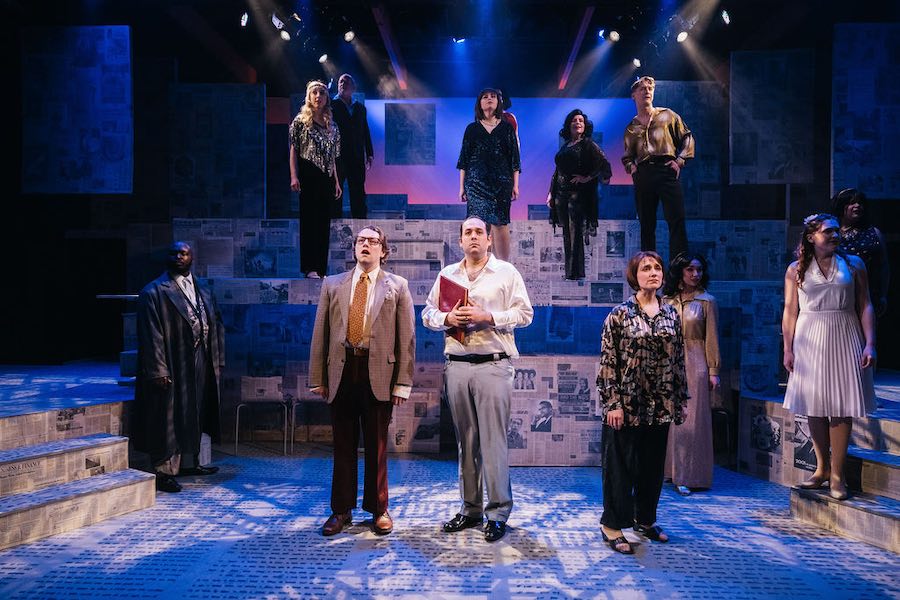How did you get to be here?
That’s the central question of Stephen Sondheim’s Merrily We Roll Along, currently in a brilliant, emotionally wrenching production at DC’s Keegan Theatre. How does the talented, idealistic Franklin Shepherd, consumed by ambition, and manipulated by a toxic wife, come to betray his friends and his own musical gifts, ending in despair?
As the story begins in 1976, we first see Frank (Ryan Burke) during the overture, alone and dejected. Sondheim and his collaborators (George Furth, Hal Prince, and James Lapine) act as archeologists, peeling away the layers of the lives of Frank and his friends Charley (Harrison Smith) and Mary (Sara Chapin), digging further back in time with each scene, excavating the choices that led them away from the glowing hope and deep friendship they felt upon first meeting in 1957.

The backward-facing chronology of the play allows Sondheim to use the arresting device of what he calls the “reverse reprise,” in which the audience first hears a song in a more recent context, and later hears what the music sounds and feels like at a previous time in the characters’ lives. The show’s best-known song, “Not a Day Goes By,” is a perfect example.
In the first act, Beth (Brigid Wallace Harper) sings the song as one of bitter heartbreak as she divorces Frank. To her credit, Harper delivers the number with restraint as well as passionate pain and anger, avoiding the temptation to make it a concert-style rendition of a hit song. Then, in the second act, Beth and Frank, positioned center stage, sing the song lovingly to each other as they exchange vows, with key words altered. Mary, alone on stage right, in subtly emphasized lighting, sings the words of the song, interspersed with those of Frank and Beth, expressing her grief as the man she hopelessly loves marries someone else.
Mary does not make demands on Frank or try to manipulate him. She tries to stay close to him by helping to maintain his other relationships. She attempts to mediate the growing estrangement between Frank and Charley and warns Beth about Gussie’s designs on her husband. With somewhat mixed motives, she urges Frank to take a vacation after his divorce from Beth. Her “Like It Was” and “Old Friends,” as well as her alcoholic tirade in the opening scene, make Chapin’s Mary an unforgettable, and deeply affecting, character.
The score is full of memorable songs. “Franklin Shepherd, Inc.,” Charley’s, hilarious/tragic on-air meltdown about Frank’s abandoning their shared dream of a meaningful show in favor of lighter “commercial” products, is as challenging a task for a singer as anything in the Sondheim canon. Smith pulls it off flawlessly. Smith’s Charley is eager, needy, and nerdy, less powerful than Frank in their relationship, but a survivor, whose life remains the most intact of the three principals by the end of the show’s 20-year timespan. Smith also gets to sing a very sweet, delicate version of another of the great songs from the score, “Good Thing Going,” a tune he and Frank write for a show they are pitching that also describes the arc of their relationship.
Frank’s ambitious, grasping second wife, Gussie (Sumie Yotsukura), is a queen of manipulation, a bringer of chaos to the lives of others she uses to achieve her aims, and ultimately someone capable of violent anger. Yotsukura’s performance shows a subtext of vulnerability in Gussie’s character, which both drives her and gives her an effective tool for seduction. She is at her most manipulative and seductive in her purringly persuasive versions of “Growing Up.”
And what of Frank? He is the hollow center of the show, around whom the other characters, and the ensemble, revolve. Frank has little if any sense of humor. He is someone who is acted upon by others: Beth, Gussie, Joe (a producer who wants Frank to write commercially successful shows with “hummable” melodies, ably played by Duane Richards II), and the fickle “Blob,” the mass of what we would now call show business “influencers.” Charley and Mary, the people closest to him, ultimately have the least impact on his choices.
Emotionally unaware, he rides the waves created by others, seldom touching the ground of his own talent, once his initial 1957–62 burst of creativity — evident in “Bobby and Jackie and Jack,” “Opening Doors,” and “Our Time” — has run its course. Burke, a fine singing actor, cannot make such a character sympathetic but as the show proceeds makes him understandable.

Merrily does well by its ensemble. Group numbers like “The Blob,” “That’s Frank,” and the “Transitions,” which establish the years in which an upcoming scene is set, are effective. Ensemble members also play important character bits, such as Tyler (Taylor Witt) or Beth’s parents (Chris Gillespie and Santina Maiolatesi). The choreography (Jennifer J. Hopkins) is lively and delightful for both the ensemble — “The Blob” is a particular hoot — and for the principals in numbers like “Bobby and Jackie and Jack,” with movement well designed to look informal while executed with precision.
Hopkins and Christina A. Coakley co-directed the production, which is tight, trusts the material and the cast, and makes optimal use of Keegan’s space. Details are clear and specific.
Matthew J. Keenan’s set, with three levels of playing area above the stage floor, provides ample and varied vertical space for the action of the show, maximizing use of the limited width of the stage. It is covered throughout by representations of newspaper pages, referencing not only, as the characters sing, that they “are the names in tomorrow’s papers,” but their situation of living surrounded by public scrutiny.
Jeremy Bennett’s projections are a marvel, shown on panels hanging above the set. Along with the sung transitions, they set the chronology of the show, with photos representing the years of various scenes (e.g., pictures of Bobby Kennedy and Martin Luther King for 1968). They also create scenes of buildings and city lights or, in conjunction with Dominic DeSalvio’s lighting design, the night sky. The lighting uses color effectively throughout to set the emotional tone of scenes.
Designer Elizabeth Morton effectively fits the show’s costumes to the variety of styles prevalent in the 20 years covered by the story, as well as to the nature of the characters. Beth’s dresses are rather wholesome girl-next-door in tone, for example, while Gussie’s tend to a more studied glamorous and slinky look. Charley wears mostly nerdy sweaters and sportcoats, while Frank, until the final scene, wears white shirts and ties with suspenders, neither seemingly changing much with the times. The ensemble costumes for the 1960s “Blob” sequence are a riot of colors.
Music director Nathan Beary Blustein’s band plays extraordinarily well, doing full justice to the typically complex score of a Sondheim musical. The orchestration of the overture includes some touches I haven’t heard before, all of which worked well.
Set in a particular period though it is, Merrily We Roll Along is not a show that becomes dated. The question “How did you get to be here?” applies to everyone’s life at some point, and to the life of a community or country as well. Keegan’s production, first class in every respect, keeps the question vividly alive.
It’s a hit.
Running Time: Two hours and 40 minutes, including a 15-minute intermission.
EXTENDED: Merrily We Roll Along plays through March 10, 2024, at the Keegan Theatre, 1742 Church Street NW, Washington DC. Tickets ($55–$65) are available online. Information about the show and credits may be found here.





My friend and I just saw the Keegan production today and we are both blown away by the brilliance of the original as well as this production. This is unbelievably good, in every possible way. I urge everyone reading this to see this show before it closes at the end of next weekend.